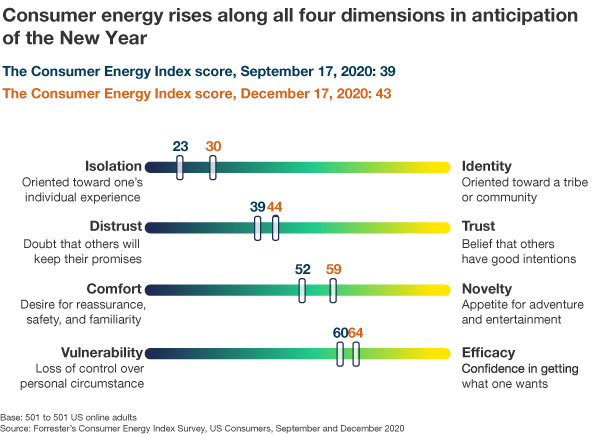Consumers Ride A Rising Tide Of Consumer Energy Into 2021
Since the onset of the COVID-19 pandemic in the US in March, we’ve been tracking precisely how the pandemic and related crises have taken an emotional toll on consumers by applying Forrester’s Consumer Energy Index, our data-driven framework that captures how ready and willing consumers are to reach out to brands.
Conditions during the first half of 2020 plunged consumers into isolation, distrust, and vulnerability and left them hovering in this low-energy state. Although announcements about business openings and episodes of activism rekindled sparks of consumer energy through the middle of the year, consumer energy dropped to a record-setting low by the end of September.
Now, as the COVID-19 vaccine distribution begins to mobilize, as the dust settles on the results of a contentious US presidential election, and as the new year looms over the horizon, consumer energy is rising again. The latest pulse reveals that, over the course of the past three months, overall consumer energy has moved from 39 up to 43, and consumer energy has grown along every key emotional dimension.

What The Data Means
At this moment:
- Consumers are beginning to feel a community connection after months of slipping deeper into isolation. Consumer energy “identity” scores have been falling ever since the onset of the pandemic in early March, as physical distancing yielded emotional isolation. Between September and December, consumers moved seven points closer towards the “identity” end of the scale, indicating that consumers were sensing stronger ties to their communities and a stronger validation of their values.
- Consumers signal a willingness to trust leaders and organizations. Consumer trust levels have also remained low during most of 2020; consumers have been apprehensive about brands’ intentions and cautious to believe that organizations will follow through on their promises. The latest five-point increase along the “trust” dimension means that consumers are relatively more open to the idea that the people and organizations around them are driven by good intentions.
- Consumers eagerly pursue and delve into novelties. Throughout the pandemic, consumers have been experiencing an emotional tug-of-war between seeking familiarity and variety. A score of 59 along the “novelty” dimension indicates that consumers’ latest desire for diversions that inform, delight, and entertain has intensified.
- Consumers discover mild confidence in their ability to recover control. Consumers’ sense of control took the biggest hit when the pandemic initially reached the US in March; since then, “efficacy” scores have remained consistent. The latest increase along the “efficacy” dimension means that consumers are starting to muster the energy and motivation to reach for new tools, resources, and solutions.
What It Means For Brands
From multiple vaccine approvals to the green-lighted stimulus bill, and from ardent holiday celebrations to the inherently hopeful arrival of the new year, consumers feel energized around ideas of innovation and sense the momentum of positive change. While mounting consumer energy signals a stronger eagerness to learn about, interact with, and reap benefits from new brand experiences, CMOs should appeal to current consumer emotions while being careful not to hype expectations that set too high a bar to match the reality of the next several months. Marketing leaders should:
- Celebrate consumers’ already-high hopes for 2021. Around 58% of US online adults believe that their quality of life next year will be better than it was this year — 23% specifically expect that life will significantly improve. Still, 21% of US online adults admit they aren’t sure how their quality of life will compare. This is the right moment for brands to offer messages that ignite inspiration and give consumers a reason to believe in the future.
- Be cautious that consumers underestimate how much more their lifestyles could change. Many consumers are pinning their hopes on the rollout of the COVID-19 vaccines: 30% of US online adults believe that because of the vaccine distribution, their lives will slowly revert to the pre-pandemic norms, and another 30% believe that their lives will continue to change in new ways, although less dramatically and significantly than they experienced in 2020. In reality, consumer work patterns and lifestyles will continue to be in flux well into 2021 as regulators, companies, and individuals adapt to the evolving conditions. The bias to underestimate imminent change not only leads consumers to miscalculate future needs and preferences but also leads to a loss of perceived brand value and ongoing feelings of dissatisfaction.
- Prepare for consumers to demand more creative, entertaining, and immersive experiences. The escalating energy around consumer identities, willingness to trust, search for novelty, and feeling of control mean that consumers are becoming confident and eager about new products and messaging; they are becoming ready for new forms of consumption that enhance their happiness and wellbeing. Consumers will channel this energy into the brands that resonate with them in this moment and help them restore the variety and excitement they’ve felt deprived of during 2020.
Questions, comments, or ideas? I look forward to sharing more data detail and discussing via inquiry.
